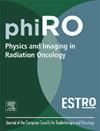0.35 T磁共振成像引导放射治疗胸廓自动分割模型的实现及临床评价
IF 3.3
Q2 ONCOLOGY
引用次数: 0
摘要
背景与目的:磁共振成像引导放射治疗(MRgRT)以耗费时间和劳动密集型的人工描绘危险器官(OARs)为代价,促进了高精度、小范围的治疗。自动分割模型在简化这一工作流程方面显示出了希望。本研究探讨了一套胸廓OAR分割模型在肺肿瘤患者基线治疗规划中的临床适用性。我们调查了这些模型在0.35 T MR-linac下的治疗使用情况,评估了它们在节省时间方面减少医生工作量的潜力,并量化了所需人工校正的程度,从而深入了解了将这些模型整合到临床实践中的价值。材料与方法:将基于深度学习的9个胸部桨叶自动分割模型集成到MRgRT工作流程中。前瞻性研究了两组11例肺癌病例。对于第一组,自动分割轮廓由医生进行校正,对于第二组,根据标准临床工作流程进行手动轮廓。记录两者的轮廓时间。分析两组之间节省的时间以及组1患者的矫正程度与矫正次数的相关性。结果:该模型在所有组1病例中均表现良好。中位轮廓时间减少了9个桨中的6个,导致中位总轮廓时间减少50.3%或12.6分钟。结论:在0.35 T MR-linac时,自动分割基线治疗计划的可行性显示出显著的时间节省。从模型的几何性能指标无法估计节省时间的潜力。本文章由计算机程序翻译,如有差异,请以英文原文为准。
Implementation and clinical evaluation of an in-house thoracic auto-segmentation model for 0.35 T magnetic resonance imaging guided radiotherapy
Background and Purpose:
Magnetic resonance imaging-guided radiotherapy (MRgRT) facilitates high accuracy, small margins treatments at the cost of time-consuming and labor-intensive manual delineation of organs-at-risk (OARs). Auto-segmentation models show promise in streamlining this workflow. This study investigates the clinical applicability of a set of thoracic OAR segmentation models for baseline treatment planning in lung tumor patients. We investigate the use of the models for treatment at a 0.35 T MR-linac, assess their potential to reduce physician workload in terms of time savings and quantify the extent of required manual corrections, providing insights into the value of their integration into clinical practice.
Materials and Methods:
Deep-learning based auto-segmentation models for 9 thoracic OARs were integrated into the MRgRT workflow. Two groups of 11 lung cancer cases each were prospectively considered. For Group 1 auto-segmentation contours were corrected by physicians, for Group 2 manual contouring according to standard clinical workflows was performed. Contouring times were recorded for both. Time savings between the groups as well as correlations of the extent of corrections to correction times for Group 1 patients were analyzed.
Results:
The model performed consistently well across all Group 1 cases. Median contouring times were reduced for six out of nine OARs leading to a reduction of 50.3 % or 12.6 min in median total contouring time.
Conclusion:
Feasibility of auto-segmentation for baseline treatment planning at the 0.35 T MR-linac was shown with significant time savings demonstrated. Time saving potential could not be estimated from model geometric performance metrics.
求助全文
通过发布文献求助,成功后即可免费获取论文全文。
去求助
来源期刊

Physics and Imaging in Radiation Oncology
Physics and Astronomy-Radiation
CiteScore
5.30
自引率
18.90%
发文量
93
审稿时长
6 weeks
 求助内容:
求助内容: 应助结果提醒方式:
应助结果提醒方式:


